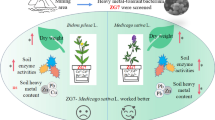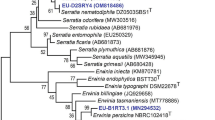Abstract
Aims
Iron plaques can prevent the uptake of heavy metals on the root surface of wetland plants. The Fe and Mn oxides produced by microorganisms are major Fe/Mn-oxidizing agents in the environment. This study is the first to investigate the influence of Fe/Mn-oxidizing bacteria on Fe/Mn plaque formation and the uptake of Cd and As on rice tissues.
Methods
The oxide indicators Fe (1,10-phenanthrolin) and Mn (leucoberbelin blue) were used to determine the Fe/Mn oxidation ratios and Fe(II)/Mn(II) oxidation ability of the isolates. Fe/Mn plaque formation on the root was determined by the dithionite–citrate–bicarbonate method. The Cd and As concentrations in different organs of rice were determined by ICP-MS.
Results
Two bacterial strains D54 and TWD-2 with Fe(II) and Mn(II) oxidation ability were isolated from heavy metal-contaminated paddy soils. Fe/Mn plaque formation on rice roots was strongly enhanced via inoculation of Fe/Mn-oxidizing strains. The inoculation of strains D54 and TWD-2 and the addition of Fe(II) significantly decreased the Cd/As concentration in the root, leaf, glume and brown rice grain of the rice plant. Moreover, the photosynthetic rate of rice leaf was enhanced by inoculation of the strains D54 and TWD-2.
Conclusions
The formation of Fe/Mn plaques on rice roots can be stimulated via the inoculation of the Fe/Mn-oxidizing strains D54 and TWD-2 combined with the addition of exogenous Fe(II). Increased Fe/Mn plaque formation promotes the deposition of metals to the root surface, thereby limiting the uptake and transfer of Cd/As in rice tissues.


Similar content being viewed by others
References
Akob DM et al. (2014) Identification of Mn(II)-oxidizing bacteria from a low-pH Contaminated former uranium mine. Appl Environ Microb 80:5086–5097
Brouwers GJ, Vijgenboom E, Corstjens PLAM, De Vrind JPM, de Vrind-de Jong EW (2000) Bacterial Mn2+ oxidizing systems and multicopper oxidases: An overview of mechanisms and functions. Geomicrobiol J 17:1–24
Byrne JM, Klueglein N, Pearce C, Rosso KM, Appel E, Kappler A (2015) Redox cycling of Fe(II) and Fe(III) in magnetite by Fe-metabolizing bacteria. Science 347:1473–1476
Chen XP, Kong WD, He JZ, Liu WJ, Smith SE, Smith FA, Zhu YG (2008) Do water regimes affect iron-plaque formation and microbial communities in the rhizosphere of paddy rice? J Plant Nutr Soil Sci-Zeitschrift Fur Pflanzenernahrung Und Bodenkunde 171:193–199
Cheng H, Wang MY, Wong MH, Ye ZH (2014) Does radial oxygen loss and iron plaque formation on roots alter Cd and Pb uptake and distribution in rice plant tissues? Plant Soil 375:137–148
Crowder AA, Coltman DW (1993) Formation of manganese oxide plaque on rice roots in solution culture under varying pH and manganese (Mn2+) concentration conditions. J Plant Nutr 16:589–599
Dong DM, Nelson YM, Lion LW, Shuler ML, Ghiorse WC (2000) Adsorption of Pb and Cd onto metal oxides and organic material in natural surface coatings as determined by selective extractions: new evidence for the importance of Mn and Fe oxides. Water Res 34:427–436
El Gheriany IA, Bocioaga D, Hay AG, Ghiorse WC, Shuler ML, Lion LW (2009) Iron requirement for Mn(II) oxidation by leptothrix discophora SS-1. Appl Environ Microb 75:1229–1235
Francis CA, Co EM, Tebo BM (2001) Enzymatic manganese(II) oxidation by a marine alpha-proteobacterium. Appl Environ Microb 67:4024–4029
Francis CA, Tebo BM (2002) Enzymatic manganese(II) oxidation by metabolically dormant spores of diverse bacillus species. Appl Environ Microb 68:874–880
Govender E, Harrison STL, Bryan CG (2012) Modification of the ferric chloride assay for the spectrophotometric determination of ferric and total iron in acidic solutions containing high concentrations of copper. Miner Eng 35:46–48
Guo JK, Chi J (2014) Effect of Cd-tolerant plant growth-promoting rhizobium on plant growth and Cd uptake by Lolium multiflorum lam. and Glycine max (L.) merr. in Cd-contaminated soil. Plant Soil 375:205–214
Hansel CM, Fendorf S, Sutton S, Newville M (2001) Characterization of Fe plaque and associated metals on the roots of mine-waste impacted aquatic plants. Environ Sci Technol 35:3863–3868
Hartke S, da Silva AA, de Moraes MG (2013) Cadmium accumulation in tomato cultivars and its effect on expression of metal transport-related genes. B Environ Contam Tox 90:227–232
Hawkes CV, DeAngelis KM, Firestone MK (2007) Understanding and managing the rhizosphere in agroecosystems. In: Cardon ZG, Whitebeck JL (eds) The rhizosphere: an ecological perspective. Elesevier, Boston, pp. 2–17
Hedrich S, Schlomann M, Johnson DB (2011) The iron-oxidizing proteobacteria. Microbiol-Sgm 157:1551–1564
Kanaparthi D, Conrad R (2015) Role of humic substances in promoting autotrophic growth in nitrate-dependent iron-oxidizing bacteria. Syst Appl Microbiol 38:184–188
Koike S, Inoue H, Mizuno D, Takahashi M, Nakanishi H, Mori S, Nishizawa NK (2004) OsYSL2 is a rice metal-nicotianamine transporter that is regulated by iron and expressed in the phloem. Plant J 39:415–424
Lauber CL, Strickland MS, Bradford MA, Fierer N (2008) The influence of soil properties on the structure of bacterial and fungal communities across land-use types. Soil Biol Biochem 40(9):2407–2415
Lee CH, Hsieh YC, Lin TH, Lee DY (2013) Iron plaque formation and its effect on arsenic uptake by different genotypes of paddy rice. Plant Soil 363:231–241
Li B, Wang X, Qi XL, Huang L, Ye ZH (2012) Identification of rice cultivars with low brown rice mixed cadmium and lead contents and their interactions with the micronutrients iron, zinc, nickel and manganese. J Environ Sci-China 24:1790–1798
Liu RP, Xu W, He Z, Lan HC, Liu HJ, Qu JH, Prasai T (2015) Adsorption of antimony(V) onto Mn(II)-enriched surfaces of manganese-oxide and Fe-Mn binary oxide. Chemosphere 138:616–624
Mayanna S, Peacock CL, Schaffner F, Grawunder A, Merten D, Kothe E, Buchel G (2015) Biogenic precipitation of manganese oxides and enrichment of heavy metals at acidic soil pH. Chem Geol 402:6–17
McLaughlin MJ, Parker DR, Clarke JM (1999) Metals and micronutrients - food safety issues. Field Crop Res 60:143–163
Mei XQ, Ye ZH, Wong MH (2009) The relationship of root porosity and radial oxygen loss on arsenic tolerance and uptake in rice grains and straw. Environ Pollut 157:2550–2557
Neubauer SC, Toledo-Duran GE, Emerson D, Megonigal JP (2007) Returning to their roots: iron-oxidizing bacteria enhance short-term plaque formation in the wetland-plant rhizosphere. Geomicrobiol J 24:65–73
Nguyen TT et al. (2015) A lithotrophic microbial fuel cell operated with pseudomonads-dominated iron-oxidizing bacteria enriched at the anode. Microb Biotechnol 8:579–589
Otte ML, Dekkers MJ, Rozema J, Broekman RA (1991) Uptake of arsenic by Aster tripolium in relation to rhizosphere oxidation. Can J Bot Rev can Bot 69:2670–2677
Quartacci MF, Argilla A, Baker AJ, Navari-Izzo F (2006) Phytoextraction of metals from a multiply contaminated soil by Indian mustard. Chemosphere 63:918–925
Salt DE, Blaylock M, Kumar NPBA, Dushenkov V, Ensley BD, Chet I, Raskin I (1995) Phytoremediation - a novel strategy for the removal of toxic metals from the environment using plants. Bio-Technol 13:468–474
Song WY et al. (2010) Arabidopsis PCR2 Is a zinc exporter involved in both zinc extrusion and long-distance zinc transport. Plant Cell 22:2237–2252
Tebo BM, Johnson HA, McCarthy JK, Templeton AS (2005) Geomicrobiology of manganese(II) oxidation. Trends Microbiol 13:421–428
Thompson IA, Huber DM, Schulze DG (2006) Evidence of a multicopper oxidase in Mn oxidation by gaeumannomyces graminis var. tritici. Phytopathology 96:130–136
Taylor GJ, Crowder AA (1983) Use of the DCB technique for extraction of hydrous iron-oxides from roots of wetland plants. Am J Bot 70:1254–1257
Torrance KW, Keenan HE, Hursthouse AS, Stirling D (2010) Measurement of arsenic and gallium content of gallium arsenide semiconductor waste streams by ICP-MS. J Environ Sci Heal A 45:471–475
Tripathi RD et al. (2014) Roles for root iron plaque in sequestration and uptake of heavy metals and metalloids in aquatic and wetland plants. Metallomics 6:1789–1800
Wang XH, Wiens M, Divekar M, Grebenjuk VA, Schroder HC, Batel R, Muller WEG (2011) Isolation and characterization of a Mn(II)-oxidizing bacillus strain from the demosponge Suberites domuncula. Mar Drugs 9:1–28
Wu C, Ye ZH, Li H, Wu SC, Deng D, Zhu YG, Wong MH (2012) Do radial oxygen loss and external aeration affect iron plaque formation and arsenic accumulation and speciation in rice? J Exp Bot 63:2961–2970
Xu W, Lan HC, Wang HJ, Liu HM, Qu JH (2015) Comparing the adsorption behaviors of Cd, Cu and Pb from water onto Fe-Mn binary oxide, MnO2 and FeOOH. Front Env Sci Eng 9:385–393
Yang JX, Tam NFY, Ye ZH (2014) Root porosity, radial oxygen loss and iron plaque on roots of wetland plants in relation to zinc tolerance and accumulation. Plant Soil 374:815–828
Zhang XK, Zhang FS, Mao DR (1998) Effect of iron plaque outside roots on nutrient uptake by rice (Oryza sativa L.). zinc uptake by Fe-deficient rice. Plant Soil 202:33–39
Zhou H et al. (2015) Heavy metal translocation and accumulation in iron plaques and plant tissues for 32 hybrid rice (Oryza sativa L.) cultivars. Plant Soil 386:317–329
Zhou XB, Shi WM, Zhang LH (2007) Iron plaque outside roots affects selenite uptake by rice seedlings (Oryza sativa L.) grown in solution culture. Plant Soil 290:17–28
Zhu YG et al. (2008) High percentage inorganic arsenic content of mining impacted and nonimpacted Chinese rice. Environ Sci Technol 42:5008–5013
Acknowledgments
This research was financially supported by the Central Public Research Institutes Basic Funds for Research and Development (Agro-Environmental Protection Institute, Ministry of Agriculture) and the National Natural Science Foundation of China (Nos. 41473115 and 41001191).
Author information
Authors and Affiliations
Corresponding authors
Additional information
Responsible Editor: Henk Schat.
Rights and permissions
About this article
Cite this article
Dong, M.F., Feng, R.W., Wang, R.G. et al. Inoculation of Fe/Mn-oxidizing bacteria enhances Fe/Mn plaque formation and reduces Cd and As accumulation in Rice Plant tissues. Plant Soil 404, 75–83 (2016). https://doi.org/10.1007/s11104-016-2829-x
Received:
Accepted:
Published:
Issue Date:
DOI: https://doi.org/10.1007/s11104-016-2829-x




